- Your cart is empty
- Continue Shopping

How does Transdermal Patches Actually Deliver Drug To Our Body?
Learn how transdermal patches deliver medication through the skin, offering controlled, non-invasive drug delivery for medical and cosmetic use.
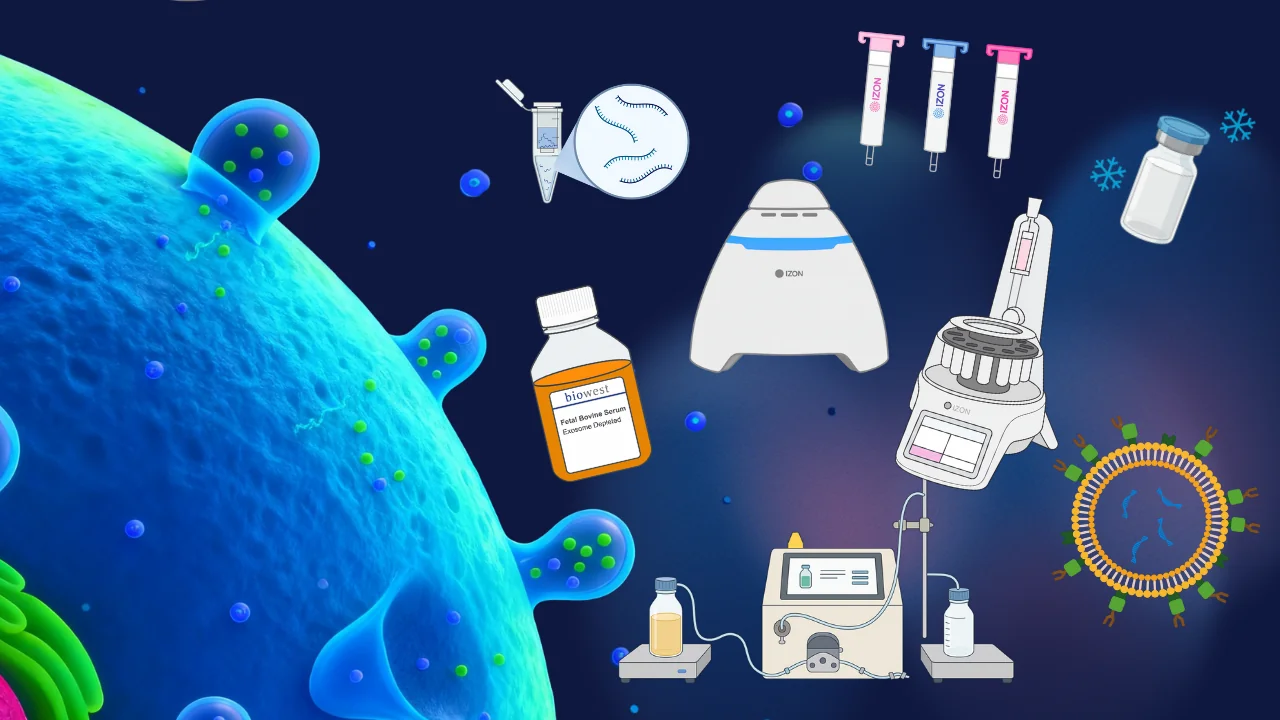
Extracellular vesicles (EVs) and exosomes are gaining increasing attention for their roles in diagnostics, therapeutics, and biomarker discovery. These tiny vesicles carry proteins, RNA, and other cargo from their parent cells, acting as natural messengers with functional impacts on recipient cells and playing a central role in cell-to-cell communication.
Exosomes are nano-sized EVs, typically 30–150 nanometres in diameter, that are secreted by most cell types and found in nearly all biological fluids — including plasma, serum, saliva, cerebrospinal fluid, urine, and cell culture media. They encapsulate diverse biomolecules from their cell of origin, such as nucleic acids, proteins, lipids, and metabolites, serving as natural carriers for intercellular communication. While exosomes were first thought to function primarily in cellular waste disposal, later studies revealed their crucial role in regulating physiological and pathological processes.
For instance, mesenchymal stem cell–derived exosomes (MSC-Exosomes) have been widely studied for their regenerative and therapeutic potential. Beyond regenerative medicine, exosomes are now explored as diagnostic and prognostic biomarkers for cancer, cardiovascular disorders, tuberculosis, and neurodegenerative diseases. Their intrinsic biocompatibility, low immunogenicity, and efficient cargo delivery also make them promising drug delivery systems, with ongoing studies investigating their applications in cancer and Alzheimer’s disease therapy.
Harnessing this potential, however, requires meticulous planning, reproducible workflows, and optimised analytical tools.
In this blog, we walk through a day in the EV lab, following a vesicle from culture through concentration, isolation, storage, characterisation, cargo analysis, and functionalisation—highlighting real lab experiences, best practices, and practical tips.
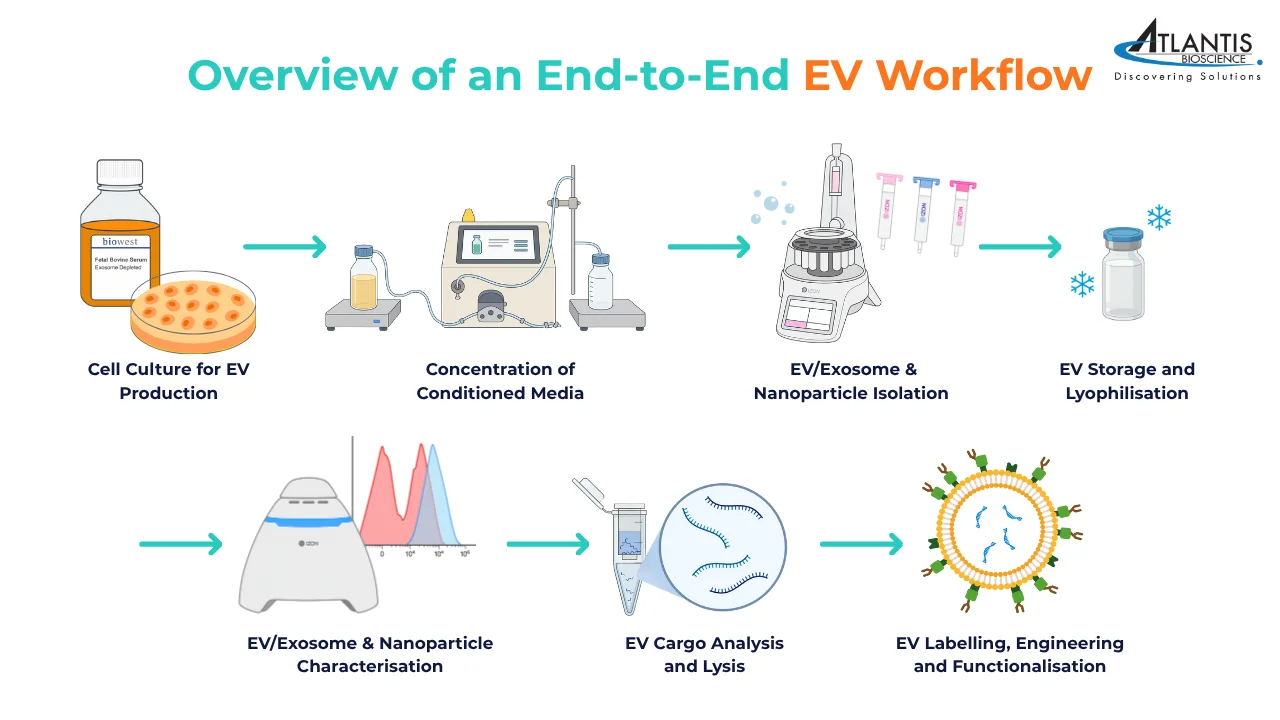
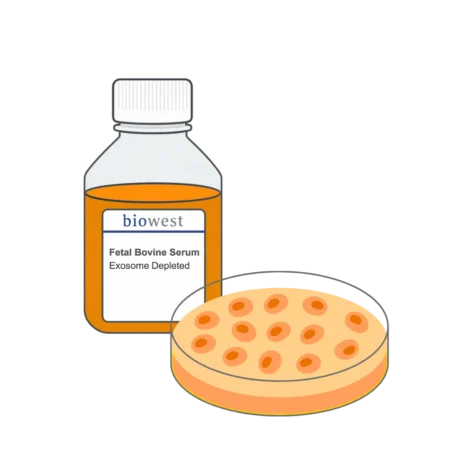
The day begins at the incubator. Your cells are thriving, but there’s a hidden challenge: the culture medium itself can introduce EV contamination. Standard fetal bovine serum (FBS) contains bovine-derived EVs and non-EV particles like lipoproteins, which can obscure results or reduce apparent yield.
| Tip | Pitfall |
| Pre-condition your media and confirm depletion of contaminating vesicles before starting experiments. | Over-confluent cell cultures can alter the therapeutic potential of MSCs due to contact-inhibited growth or contact-induced senescence. |
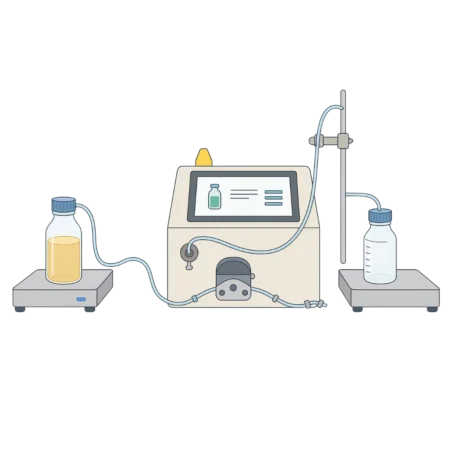
After the culture period, your conditioned media is rich in EVs—but they are dispersed across large volumes, making isolation inefficient. In most EV workflows, samples are first concentrated (typically 5–40×) before purification because conditioned media are often too dilute to process directly. Concentration is therefore a crucial bridge between culture and isolation.
| Tip | Pitfall |
| Monitor flow rate and pressure to avoid vesicle deformation. | Over-concentration can increase viscosity, leading to aggregation or losses during subsequent isolation. |
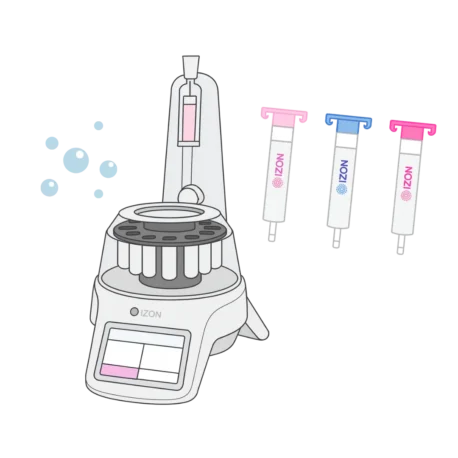
Purity is everything. After concentration with TFF, your sample is denser but still contains unwanted proteins, lipoproteins, and other non-vesicular particles. To obtain biologically relevant and reproducible data, these contaminants must be removed—this is where true EV isolation begins.
| Tip | Pitfall |
| Match your isolation method to your sample volume and throughput needs. | Skipping column equilibration or insufficient washing can introduce contaminants that compromise downstream characterisation. |
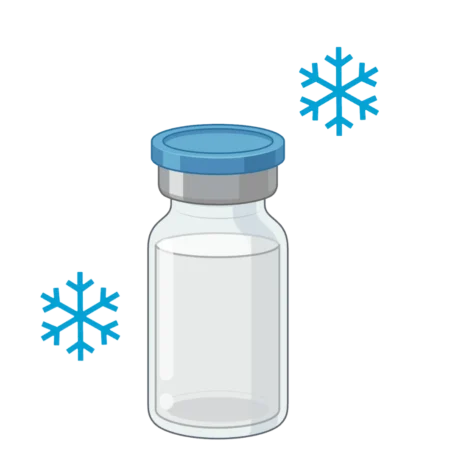
After isolation, proper storage is essential to maintain EV functionality. Vesicles are delicate—improper conditions can compromise membrane integrity, cause aggregation, or degrade their RNA and protein cargo. Yet, storage remains one of the least standardised steps in EV workflows.
Typically, isolated EVs are resuspended in phosphate-buffered saline (PBS) and stored at −80 °C or lower, as refrigeration at 4 °C leads to loss of particle number, altered size distribution, and decreased expression of surface markers. Even at −80 °C, repeated freeze–thaw cycles can rupture vesicles and cause aggregation.
To address these challenges, researchers have turned to lyophilisation (freeze-drying). As highlighted in recent studies, lyophilised EVs—especially those stabilised in protective buffers—can retain their size, morphology, and biological function for extended periods, even at room temperature. This approach offers a more practical and cost-effective alternative for long-term EV preservation and transport without constant cold-chain dependency.
| Tip | Pitfall |
| Always aliquot EVs into single-use volumes to prevent degradation from repeated thawing. | Freezing or thawing EVs without cryoprotectants can rupture vesicles and degrade RNA/protein cargo, significantly affecting assay reproducibility. |
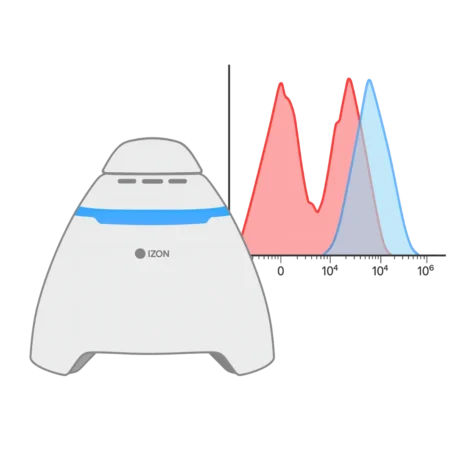
Isolation alone doesn’t confirm success. Characterisation validates what you’ve truly isolated—ensuring that your sample contains intact EVs rather than protein aggregates or lipoproteins. Proper characterisation is critical for reproducibility, comparability between studies, and ensuring that observed biological effects are indeed mediated by EVs.
Physical and surface characterisation provides insight into size, concentration, zeta potential, and membrane composition—key parameters that influence EV stability, cellular uptake, and functional behaviour. Knowing the size distribution helps distinguish small EVs (exosomes, ~30–150 nm) from microvesicles or non-vesicular particles. Zeta potential reflects surface charge and colloidal stability, while particle concentration informs accurate dosing in functional assays.
| Tip | Pitfall |
| – Use orthogonal characterisation methods—TRPS, TEM, flow cytometry, and Western blot—to comprehensively understand your EV prep. – ExoBrite™ reduces aggregation and background compared to traditional dyes, ensuring more accurate flow cytometry results. | – Over-reliance on a single technique, such as DLS or NTA, can misrepresent size or concentration, particularly in polydisperse samples. – Skipping validation of surface markers may overlook heterogeneous subpopulations or contaminants, affecting downstream functional studies. |
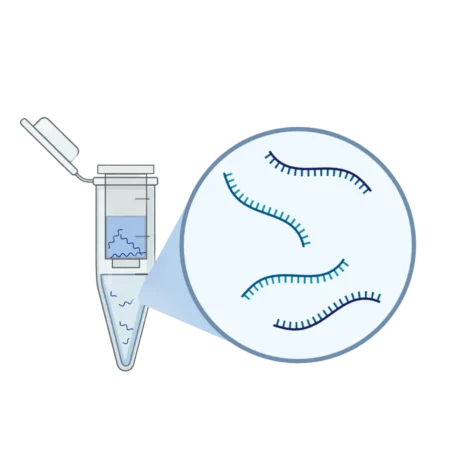
The true story of EVs lies within. While isolation and physical characterisation confirm the presence of vesicles, it is their molecular cargo—RNA, proteins, and other biomolecules—that often drives their biological activity. Understanding what EVs carry is essential for uncovering their role in intercellular communication, identifying disease biomarkers, and developing EV-based therapeutics.
| Tip | Pitfall |
| – Always use EV-specific lysis buffers to preserve RNA and protein quality, especially for sensitive assays like NGS or mass spectrometry. – Combine molecular profiling with functional assays to validate that the cargo is biologically active. | – Harsh lysis conditions can fragment RNA or denature proteins, compromising downstream analyses and obscuring functional insights. – Skipping proper lysis or purification steps may leave membrane remnants that interfere with accurate cargo quantification. |

Finally, your EVs are ready for advanced applications. Beyond their natural biological roles, EVs can be tracked, loaded with therapeutic cargo, or surface-modified to enhance targeting, delivery efficiency, and stability. Functionalisation enables EVs to become therapeutic and diagnostic tools, allowing researchers to direct them to specific tissues, protect cargo like RNA or drugs from degradation, and enable real-time tracking for diagnostics. This customisation unlocks capabilities far beyond what natural EVs can achieve alone.
| Tip | Pitfall |
| – Optimise cargo load and surface modifications to preserve natural EV behaviour and uptake efficiency. – Verify EV integrity post-functionalisation with characterization methods (Exoid, flow cytometry, TEM) before downstream applications. | – Overloading cargo or excessive surface modification can destabilise EVs, impair cellular uptake, or trigger unwanted immune responses. |
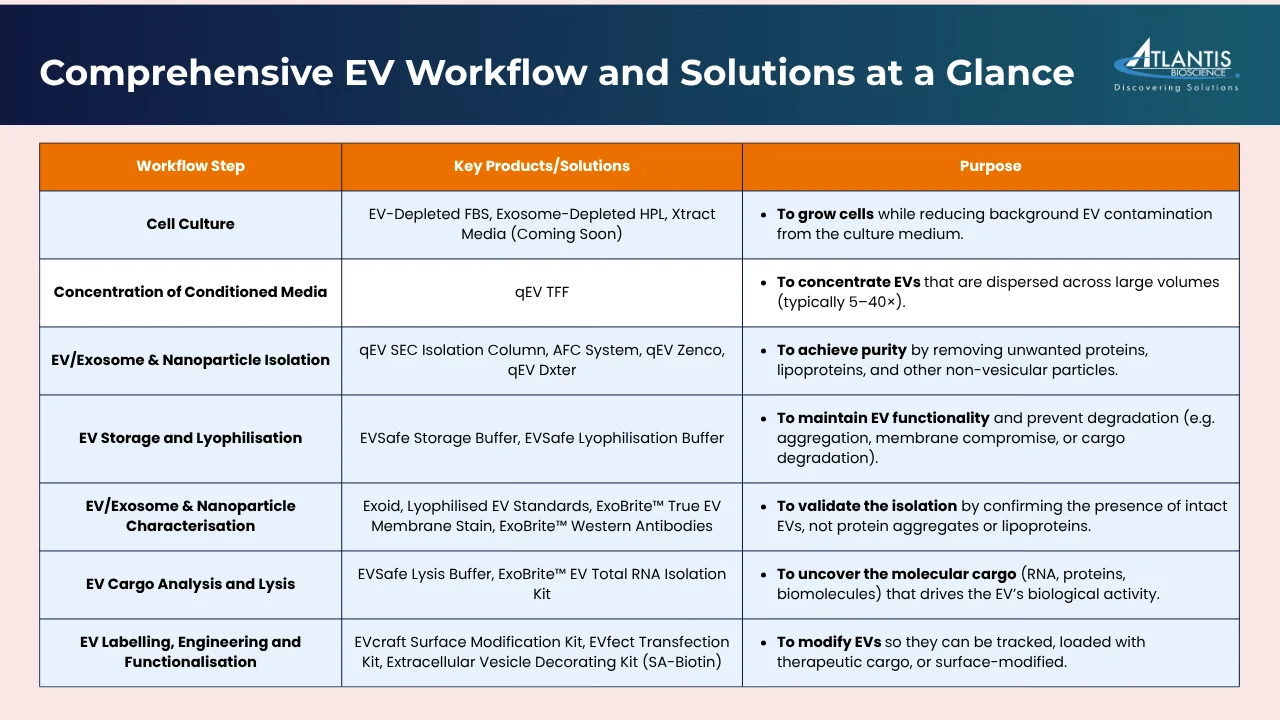
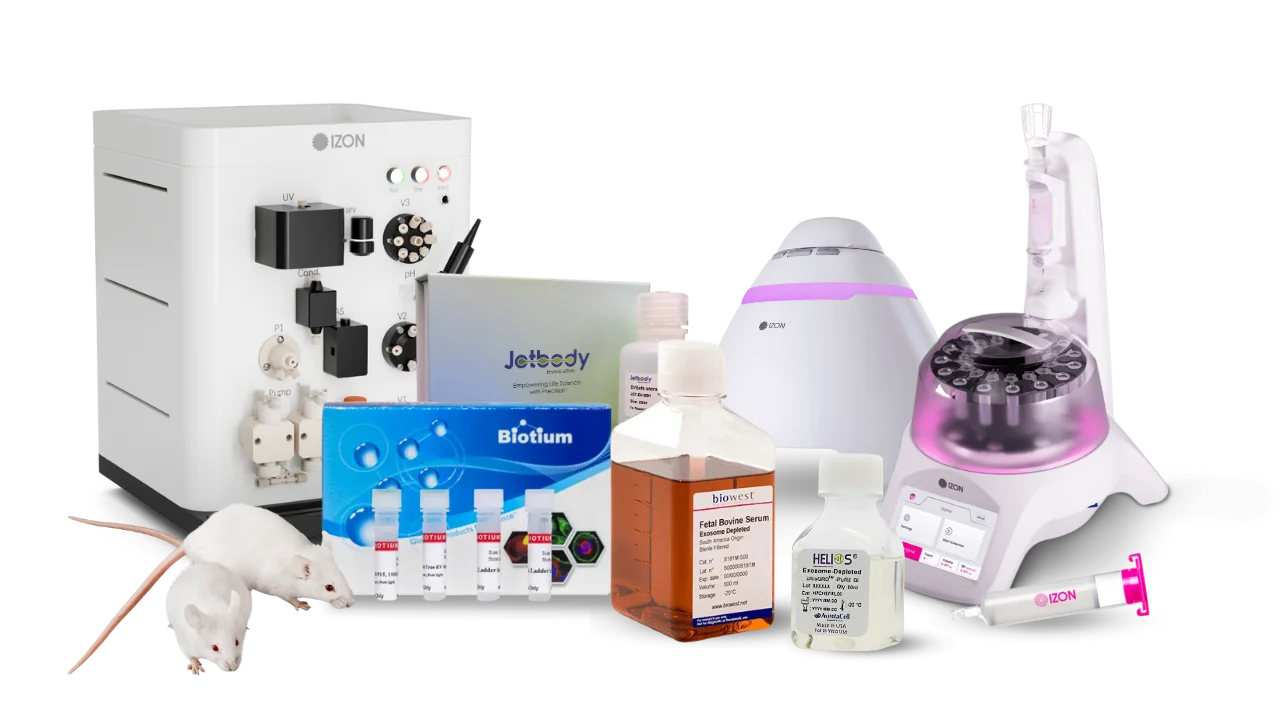
Many researchers have successfully incorporated our EV solutions into their workflows to achieve higher purity, reproducibility, and data confidence. Below are a few examples of how these tools have supported real-world applications across EV-based studies.
Atlantis Bioscience supported a pharmaceutical innovator in characterising Virus-Like Particles (VLPs) for protein interaction studies. Understanding these interactions is crucial for optimising antigen presentation and improving the performance of protein- and antibody-based therapeutics.
To achieve this, we introduced the Exoid, a next-generation nanoparticle characterisation system powered by Tunable Resistive Pulse Sensing (TRPS) technology. The Exoid enables simultaneous measurement of particle size, concentration, and zeta potential (40 nm – 11 µm range) using only 35 µL of sample — providing precise, reproducible data while ensuring batch-to-batch consistency.
By adopting this approach, the team achieved higher analytical accuracy while significantly reducing outsourcing costs and processing time, demonstrating how advanced TRPS technology supports both efficiency and reliability in nanoparticle and EV research.
A research group at a higher education institution is investigating the therapeutic potential of MSC-EVs, which are tiny biological messengers that may one day play a role in transforming cancer therapy.
In their study, the team used the Exoid to characterise EVs collected from conditioned MSC medium. By analysing particle size, concentration and zeta potential, they gained valuable insights that guided their efforts to engineer EVs carrying therapeutic agents designed to target cancer cells more effectively.
Atlantis Bioscience supported this work with qEV isolation columns that produced highly purified EVs, free from protein and lipoprotein interference. This ensured greater accuracy in downstream characterisation and molecular analysis. The use of Biowest media and reagents further improved the quality and consistency of cell culture.
With the right tools and quality consumables, this project is moving steadily toward preclinical validation and eventual GMP-ready development as planned. Atlantis Bioscience supports every stage of this journey, holding true to our core value of bridging science from bench to bed.
A research group studying host–pathogen interactions is investigating how infectious agents communicate with and modulate the immune system. As part of their studies, the team isolated EVs from mouse plasma to explore how vesicle-mediated communication contributes to immune regulation during infection. To visualise and analyse these EVs, they adopted ExoBrite™ True EV Membrane Stain, a reagent optimised for clear, low-background labelling in flow cytometry.
The ExoBrite™ stain enabled precise detection of plasma-derived EVs without aggregation or false-positive signals, even at minimal volumes. Following SEC purification, fluorescence signals remained sharp and consistent, confirming that the isolated vesicles were intact and specific.
The researchers shared their experience with us:
“ExoBrite stains EV membranes very effectively and provides clear visualisation. It works especially well after SEC column purification, giving confidence that isolated EVs are being detected. Even with just 1 µL of stain, the signal is sharp and reliable.”
With improved staining accuracy and reproducibility, the team gained deeper insight into the molecular composition of EVs involved in infection-related communication.
Watch our EV & Exosome workflow solutions:
Working with EVs is meticulous, but rewarding. From cell culture to isolation, storage, characterisation, and functionalisation, every step shapes vesicle quality and reproducibility. Using a structured workflow with optimised tools unlocks their full potential.
EVs are more than particles—they are messengers, therapeutic vehicles, and diagnostic tools. By integrating careful planning, complementary analytical techniques, and advanced functionalisation, researchers can translate meticulous lab work into meaningful scientific insights and therapeutic innovations.
Whether your focus is biomarker discovery, drug delivery, or mechanistic studies, the right workflow makes all the difference.
Explore our EV solutions — from isolation and characterisation to storage and functionalisation — to achieve reproducible, high-quality results and accelerate your extracellular vesicle research.
References:
Gabaran SG, Ghasemzadeh N, Rahnama M, Karatas E, Akbari A, Rezaie J. Functionalized exosomes for targeted therapy in cancer and regenerative medicine: genetic, chemical, and physical modifications. Cell Commun Signal. 2025 Jun 4;23(1):265. doi: 10.1186/s12964-025-02268-y.
Morozumi M, Izumi H, Shimizu T, Takeda Y. Comparison of isolation methods using commercially available kits for obtaining extracellular vesicles from cow milk. J Dairy Sci. 2021 Jun;104(6):6463-6471. doi: 10.3168/jds.2020-19849.
Shekari F, Alibhai FJ, Baharvand H, Börger V, Bruno S, Davies O, Giebel B, Gimona M, Salekdeh GH, Martin-Jaular L, Mathivanan S, Nelissen I, Nolte-‘t Hoen E, O’Driscoll L, Perut F, Pluchino S, Pocsfalvi G, Salomon C, Soekmadji C, Staubach S, Torrecilhas AC, Shelke GV, Tertel T, Zhu D, Théry C, Witwer K, Nieuwland R. Cell culture-derived extracellular vesicles: Considerations for reporting cell culturing parameters. J Extracell Biol. 2023 Oct 16;2(10):e115. doi: 10.1002/jex2.115.
Sivanantham A, Jin Y. Impact of Storage Conditions on EV Integrity/Surface Markers and Cargos. Life (Basel). 2022 May 7;12(5):697. doi: 10.3390/life12050697.
Vogel R, Savage J, Muzard J, Camera GD, Vella G, Law A, Marchioni M, Mehn D, Geiss O, Peacock B, Aubert D, Calzolai L, Caputo F, Prina-Mello A. Measuring particle concentration of multimodal synthetic reference materials and extracellular vesicles with orthogonal techniques: Who is up to the challenge? J Extracell Vesicles. 2021 Jan;10(3):e12052. doi: 10.1002/jev2.12052.

Connect With Our Technical Specialist.

Request For A Quotation.

Learn how transdermal patches deliver medication through the skin, offering controlled, non-invasive drug delivery for medical and cosmetic use.
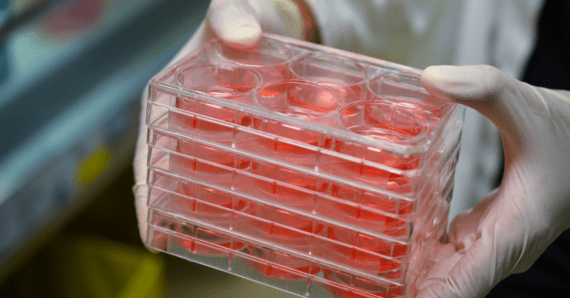
Mesenchymal stem cells (MSCs) hold immense promise in regenerative medicine due to their multilineage differentiation potential. However, large-scale expansion of these therapeutic cells can be
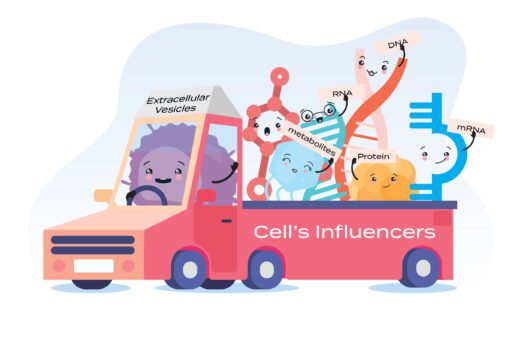
Extracellular vesicles (EVs) are revolutionising our understanding of cell-to-cell communication. These ubiquitous messengers encased in a lipid bilayer membrane, are nano-sized packages actively released by

Contact our Customer Care, Sales & Scientific Assistance

Consult and asked questions about our products & services

Documentation of Technical & Safety Data Sheet, Guides and more...